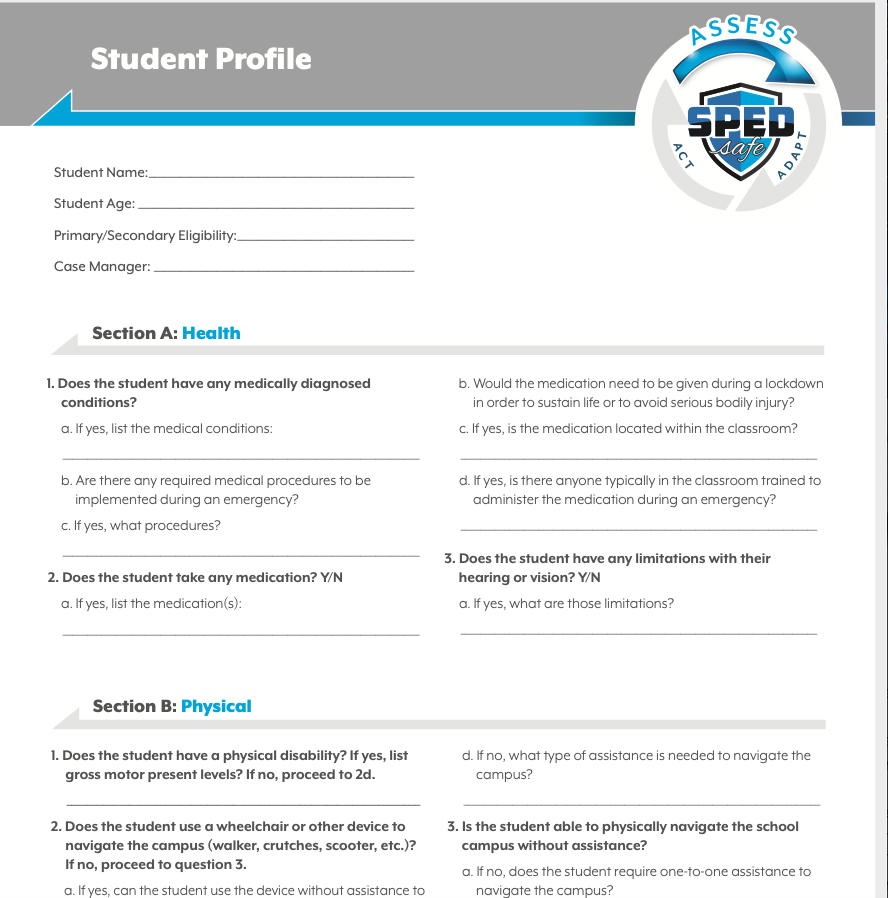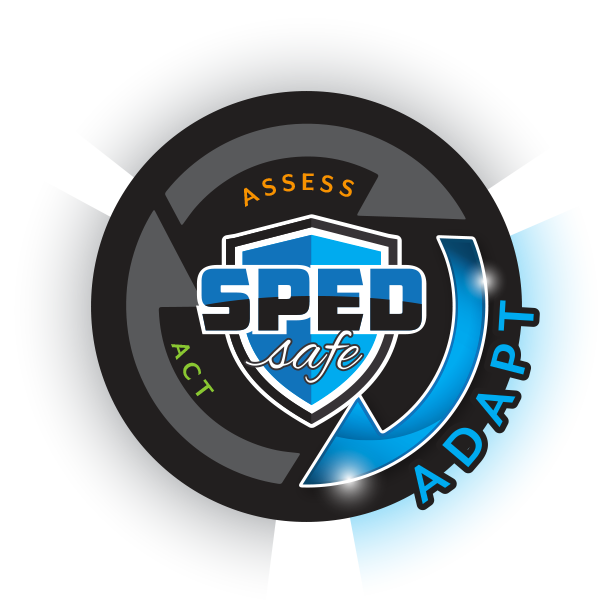Emergencies and Disasters Series
.png)
Special education professionals are experts in modifying, accommodating, differentiating, and adapting curriculum based on the individualized needs of students with disabilities. In the academic environment, the individual needs of students with disabilities are addressed through Specially Designed Instruction.
Developed by a team of experts in Special Education and Law Enforcement, SPED Safe utilizes the framework of Assess, Adapt, Act to guide multi-disciplinary teams through the steps of developing and implementing Specialized Preparedness for Emergencies and Disasters, addressing the needs of all students with disabilities. SPED Safe’s comprehensive program builds upon existing preparedness plans, leveraging training, resources, and expertise that exists within school districts.
Assess
.png)
In the Assess phase, special educators rely on their expertise, abilities and experience to gather information specific to the needs of their individual students and programs using the developed SPED Safe questionnaires. Through the completion of the Student Profile, Classroom Environmental Analysis, and/or Parent/Community Input, SPED Safe gathers information in identified areas specific to the nature of special education that are often overlooked in typical school safety plans. This phase also relies heavily on interviews and consultations with numerous stakeholders including parents, administrators, local law enforcement, paraprofessionals, and outside service providers. This valuable information is later used in the Adapt phase to drive team discussions and considerations for more inclusive school safety plans. students, including students with disabilities, react to disasters and emergencies in different ways. How a student reacts can depend on many factors including their educational background, health, cognitive ability, and many other factors. SPED Safe is committed to knowing what factors will influence how a student will respond during an emergency to make sure all staff members are prepared to best protect the student during an emergency. The SPED Safe curriculum includes a questionnaire that highlights important factors and identifies areas of the school safety pan that will need to be adapted to meet the individual student needs.
Student Questionnaire

All students, including students with disabilities, react to disasters and emergencies in different ways. How a student reacts can depend on many factors including their educational background, health, cognitive ability, and many other factors. SPED Safe is committed to knowing what factors will influence how a student will respond during an emergency to make sure all staff members are prepared to best protect the student during an emergency. The SPED Safe curriculum includes a questionnaire that highlights important factors and identifies areas of the school safety pan that will need to be adapted to meet the individual student needs.
Classroom Environmental Analysis
.png)
Many students with disabilities receive their instruction in general education settings. However, there are also students who receive a large percentage of their instruction in specialized classroom settings. Due to the nature of some of the student's disabilities in these classrooms, including health issues, mobility issues, cognitive challenges, and specialized equipment, unique challenges may arise for teachers and staff members as they try to safely respond to a disaster or emergency. SPED Safe takes these issues seriously by utilizing a classroom/environmental questionnaire to ensure the environment where the students receive their instruction is ready for any disaster or emergency.
Parent/Community Input
.png)
Students with disabilities have Individualized Education Programs (IEPs) that thoroughly address needs identified through multi-disciplinary assessments. These assessments primarily look at the students ability to access the general education curriculum and receive educational benefit in the school environment. However, students with disabilities spend a significant portion of their day outside of the school environment and information from this setting is vital for adequate planning in the event of a disaster or emergency.

Adapt
In the Adapt phase, special educators analyze and synthesize the data they gathered during the Assess phase of the SPED Safe program. Using this information they adapt the existing school safety plan to the needs of students with disabilities. For self-contained special education classrooms and/or for students with more unique needs, SPED Safe offers a comprehensive SPED Safe Classroom Plan and a SPED Safe Individualized Student Safety Plan.
Act
In the Act phase, information gathered and completed during the Assess and Adapt phases are used to develop the SPED Safe Action Plan.
.png)
SPED Safe Action Plan Checklist
The SPED Safe Action Plan provides a checklist of action items and best practices to successfully implement the SPED Safe Classroom Plan and/or Individualized Student Plan, along with suggested curriculum adaptations, instructional practice, and communication/collaboration with first responders and stakeholders.
.png)